3101AFE Accounting Theory and Practice - Exam Q&A, Woolworths, T1 2019
VerifiedAdded on 2023/06/03
|6
|1007
|492
Homework Assignment
AI Summary
This assignment provides detailed answers to questions related to accounting theory and practice. It covers topics such as Positive Accounting Theory (PAT) and its implications for aligning managerial and owner interests, the role of contractual agreements with debt holders, and the use of conservative accounting methods. The assignment also explores the debt/equity hypothesis, using Kahuna Company Limited as an example, and analyzes Woolworths Limited's revenue recognition practices based on its 2018 annual report. The solutions discuss the professional judgements used by Woolworths in revenue measurement, including the transfer of risks and rewards to customers and the reliability of revenue estimation. Desklib provides access to this and other solved assignments to aid students in their studies.
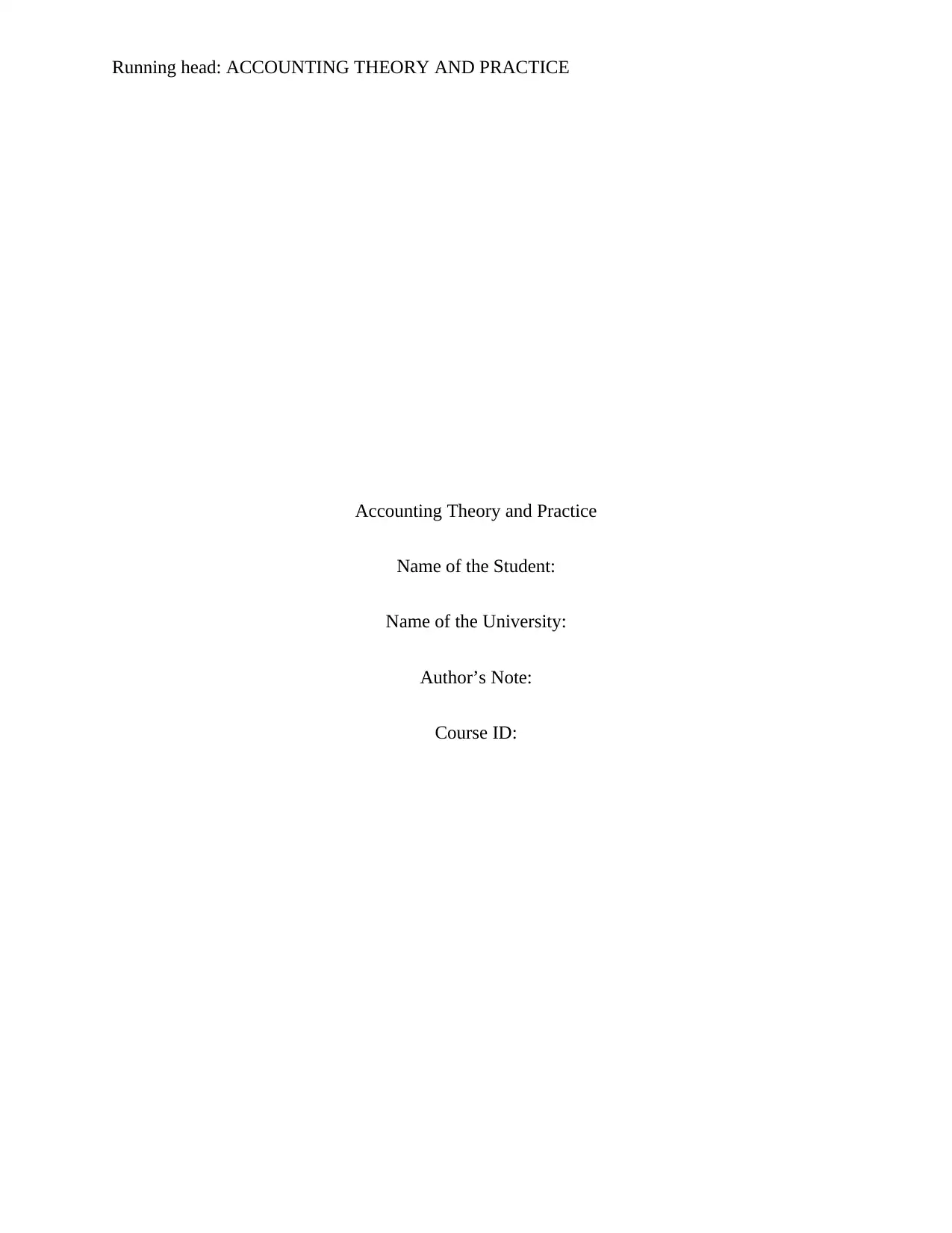
Running head: ACCOUNTING THEORY AND PRACTICE
Accounting Theory and Practice
Name of the Student:
Name of the University:
Author’s Note:
Course ID:
Accounting Theory and Practice
Name of the Student:
Name of the University:
Author’s Note:
Course ID:
Paraphrase This Document
Need a fresh take? Get an instant paraphrase of this document with our AI Paraphraser
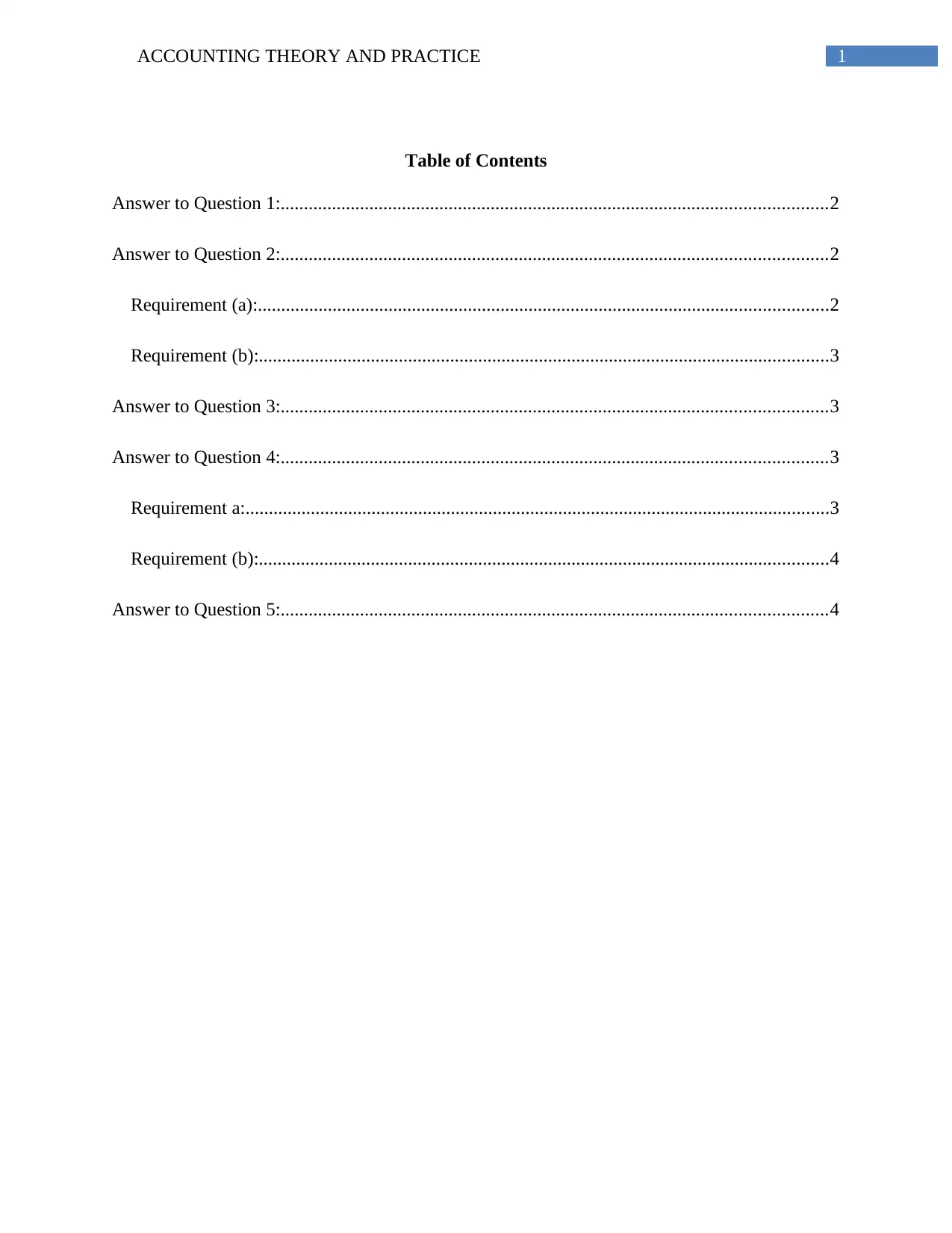
1ACCOUNTING THEORY AND PRACTICE
Table of Contents
Answer to Question 1:.....................................................................................................................2
Answer to Question 2:.....................................................................................................................2
Requirement (a):..........................................................................................................................2
Requirement (b):..........................................................................................................................3
Answer to Question 3:.....................................................................................................................3
Answer to Question 4:.....................................................................................................................3
Requirement a:.............................................................................................................................3
Requirement (b):..........................................................................................................................4
Answer to Question 5:.....................................................................................................................4
Table of Contents
Answer to Question 1:.....................................................................................................................2
Answer to Question 2:.....................................................................................................................2
Requirement (a):..........................................................................................................................2
Requirement (b):..........................................................................................................................3
Answer to Question 3:.....................................................................................................................3
Answer to Question 4:.....................................................................................................................3
Requirement a:.............................................................................................................................3
Requirement (b):..........................................................................................................................4
Answer to Question 5:.....................................................................................................................4
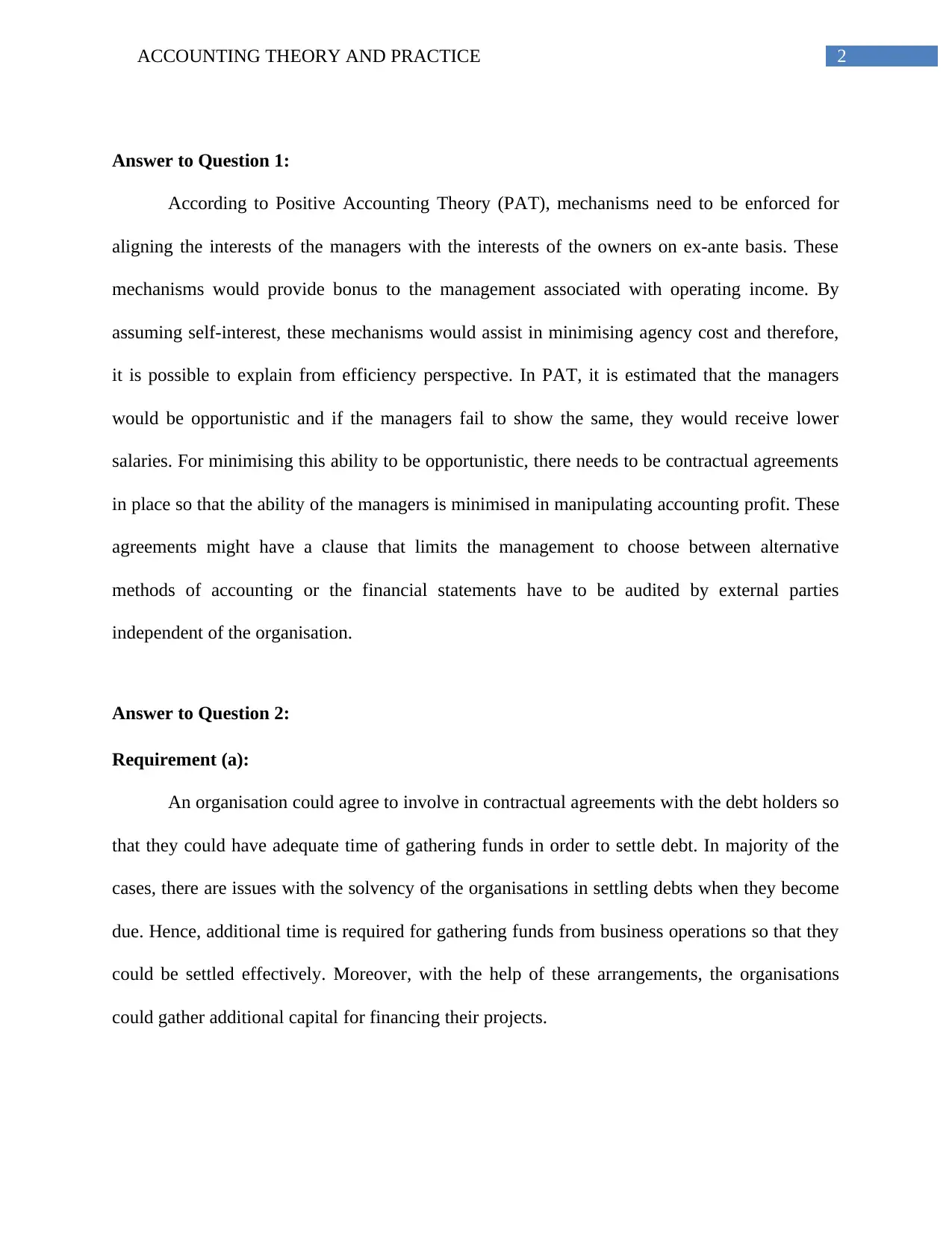
2ACCOUNTING THEORY AND PRACTICE
Answer to Question 1:
According to Positive Accounting Theory (PAT), mechanisms need to be enforced for
aligning the interests of the managers with the interests of the owners on ex-ante basis. These
mechanisms would provide bonus to the management associated with operating income. By
assuming self-interest, these mechanisms would assist in minimising agency cost and therefore,
it is possible to explain from efficiency perspective. In PAT, it is estimated that the managers
would be opportunistic and if the managers fail to show the same, they would receive lower
salaries. For minimising this ability to be opportunistic, there needs to be contractual agreements
in place so that the ability of the managers is minimised in manipulating accounting profit. These
agreements might have a clause that limits the management to choose between alternative
methods of accounting or the financial statements have to be audited by external parties
independent of the organisation.
Answer to Question 2:
Requirement (a):
An organisation could agree to involve in contractual agreements with the debt holders so
that they could have adequate time of gathering funds in order to settle debt. In majority of the
cases, there are issues with the solvency of the organisations in settling debts when they become
due. Hence, additional time is required for gathering funds from business operations so that they
could be settled effectively. Moreover, with the help of these arrangements, the organisations
could gather additional capital for financing their projects.
Answer to Question 1:
According to Positive Accounting Theory (PAT), mechanisms need to be enforced for
aligning the interests of the managers with the interests of the owners on ex-ante basis. These
mechanisms would provide bonus to the management associated with operating income. By
assuming self-interest, these mechanisms would assist in minimising agency cost and therefore,
it is possible to explain from efficiency perspective. In PAT, it is estimated that the managers
would be opportunistic and if the managers fail to show the same, they would receive lower
salaries. For minimising this ability to be opportunistic, there needs to be contractual agreements
in place so that the ability of the managers is minimised in manipulating accounting profit. These
agreements might have a clause that limits the management to choose between alternative
methods of accounting or the financial statements have to be audited by external parties
independent of the organisation.
Answer to Question 2:
Requirement (a):
An organisation could agree to involve in contractual agreements with the debt holders so
that they could have adequate time of gathering funds in order to settle debt. In majority of the
cases, there are issues with the solvency of the organisations in settling debts when they become
due. Hence, additional time is required for gathering funds from business operations so that they
could be settled effectively. Moreover, with the help of these arrangements, the organisations
could gather additional capital for financing their projects.
⊘ This is a preview!⊘
Do you want full access?
Subscribe today to unlock all pages.

Trusted by 1+ million students worldwide
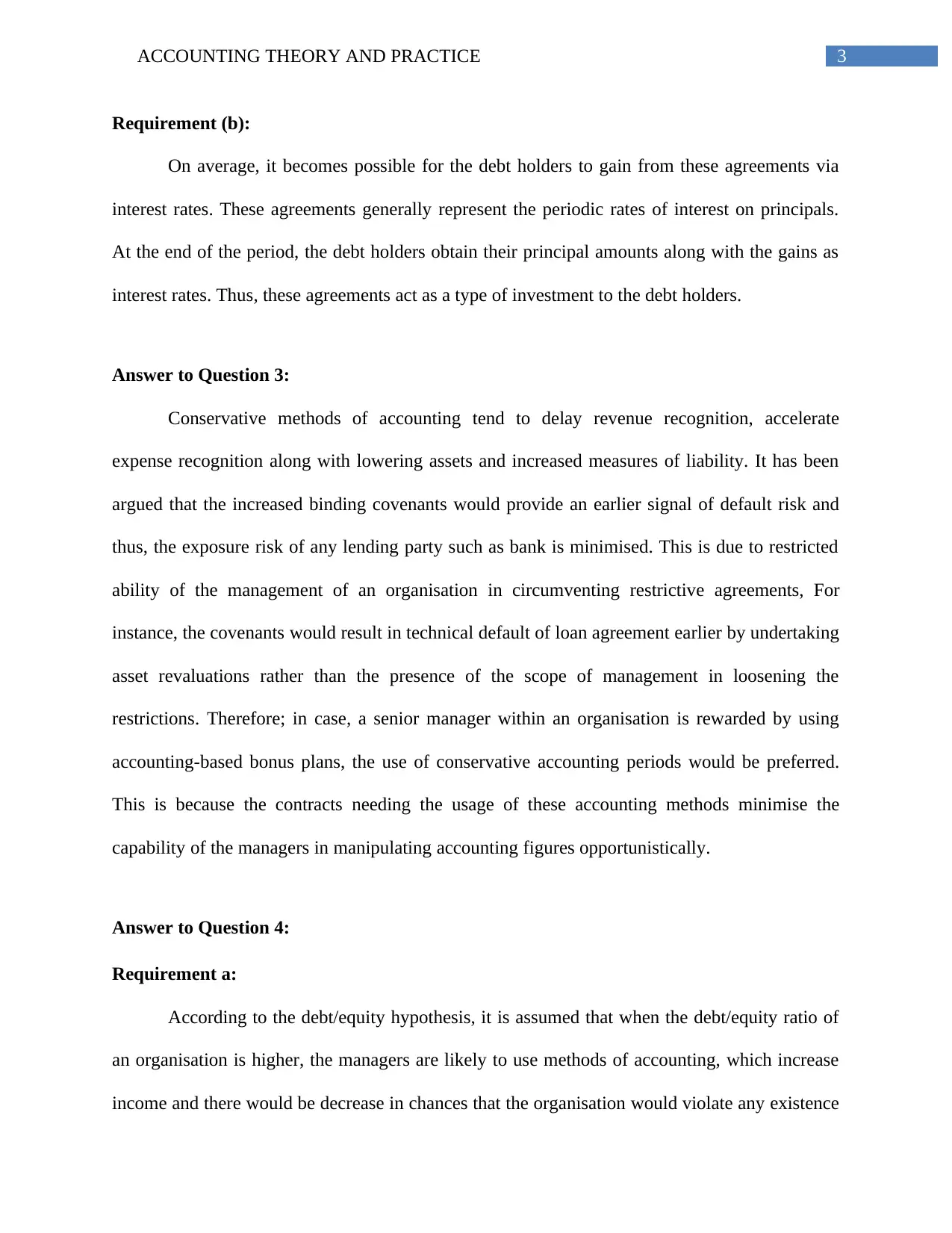
3ACCOUNTING THEORY AND PRACTICE
Requirement (b):
On average, it becomes possible for the debt holders to gain from these agreements via
interest rates. These agreements generally represent the periodic rates of interest on principals.
At the end of the period, the debt holders obtain their principal amounts along with the gains as
interest rates. Thus, these agreements act as a type of investment to the debt holders.
Answer to Question 3:
Conservative methods of accounting tend to delay revenue recognition, accelerate
expense recognition along with lowering assets and increased measures of liability. It has been
argued that the increased binding covenants would provide an earlier signal of default risk and
thus, the exposure risk of any lending party such as bank is minimised. This is due to restricted
ability of the management of an organisation in circumventing restrictive agreements, For
instance, the covenants would result in technical default of loan agreement earlier by undertaking
asset revaluations rather than the presence of the scope of management in loosening the
restrictions. Therefore; in case, a senior manager within an organisation is rewarded by using
accounting-based bonus plans, the use of conservative accounting periods would be preferred.
This is because the contracts needing the usage of these accounting methods minimise the
capability of the managers in manipulating accounting figures opportunistically.
Answer to Question 4:
Requirement a:
According to the debt/equity hypothesis, it is assumed that when the debt/equity ratio of
an organisation is higher, the managers are likely to use methods of accounting, which increase
income and there would be decrease in chances that the organisation would violate any existence
Requirement (b):
On average, it becomes possible for the debt holders to gain from these agreements via
interest rates. These agreements generally represent the periodic rates of interest on principals.
At the end of the period, the debt holders obtain their principal amounts along with the gains as
interest rates. Thus, these agreements act as a type of investment to the debt holders.
Answer to Question 3:
Conservative methods of accounting tend to delay revenue recognition, accelerate
expense recognition along with lowering assets and increased measures of liability. It has been
argued that the increased binding covenants would provide an earlier signal of default risk and
thus, the exposure risk of any lending party such as bank is minimised. This is due to restricted
ability of the management of an organisation in circumventing restrictive agreements, For
instance, the covenants would result in technical default of loan agreement earlier by undertaking
asset revaluations rather than the presence of the scope of management in loosening the
restrictions. Therefore; in case, a senior manager within an organisation is rewarded by using
accounting-based bonus plans, the use of conservative accounting periods would be preferred.
This is because the contracts needing the usage of these accounting methods minimise the
capability of the managers in manipulating accounting figures opportunistically.
Answer to Question 4:
Requirement a:
According to the debt/equity hypothesis, it is assumed that when the debt/equity ratio of
an organisation is higher, the managers are likely to use methods of accounting, which increase
income and there would be decrease in chances that the organisation would violate any existence
Paraphrase This Document
Need a fresh take? Get an instant paraphrase of this document with our AI Paraphraser
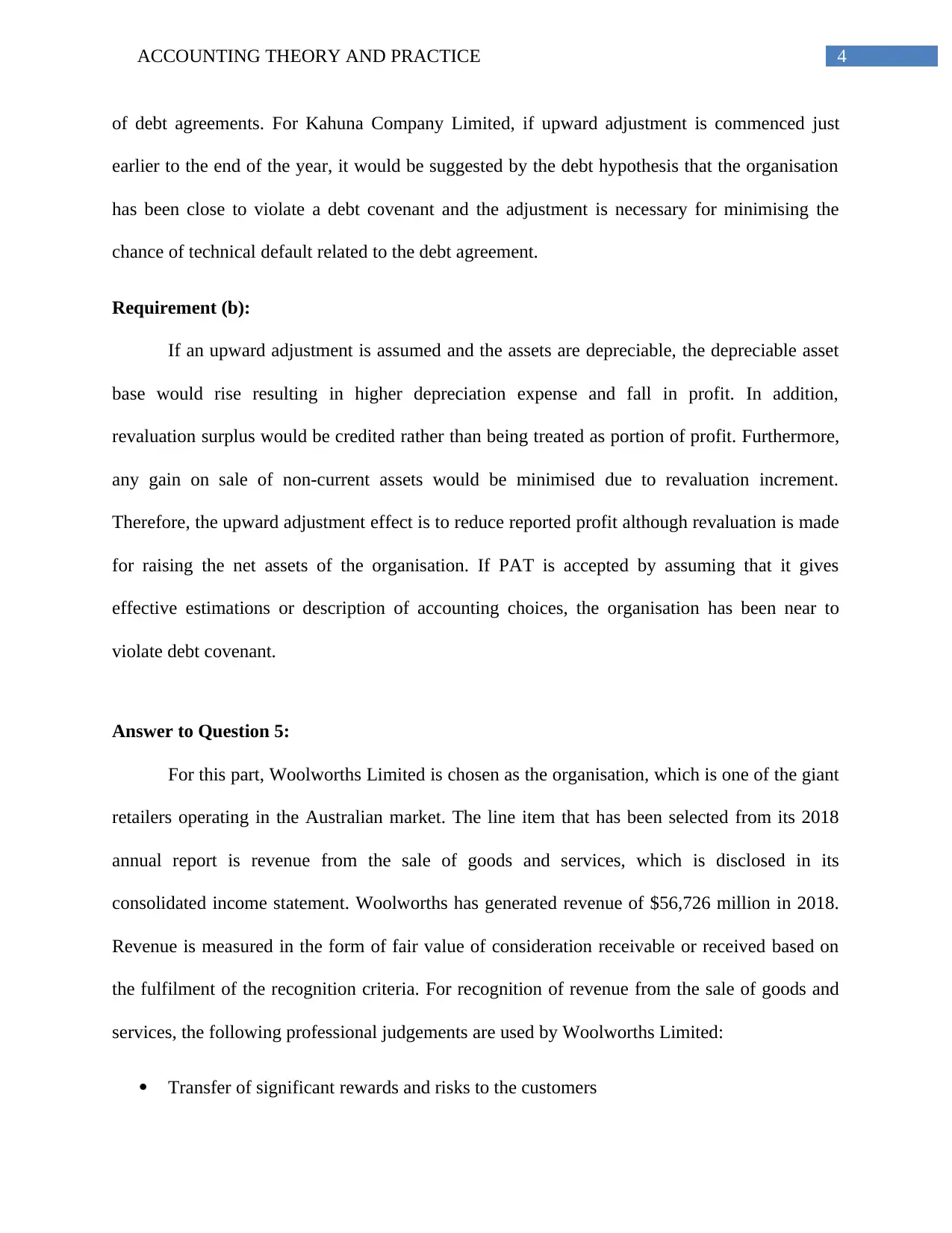
4ACCOUNTING THEORY AND PRACTICE
of debt agreements. For Kahuna Company Limited, if upward adjustment is commenced just
earlier to the end of the year, it would be suggested by the debt hypothesis that the organisation
has been close to violate a debt covenant and the adjustment is necessary for minimising the
chance of technical default related to the debt agreement.
Requirement (b):
If an upward adjustment is assumed and the assets are depreciable, the depreciable asset
base would rise resulting in higher depreciation expense and fall in profit. In addition,
revaluation surplus would be credited rather than being treated as portion of profit. Furthermore,
any gain on sale of non-current assets would be minimised due to revaluation increment.
Therefore, the upward adjustment effect is to reduce reported profit although revaluation is made
for raising the net assets of the organisation. If PAT is accepted by assuming that it gives
effective estimations or description of accounting choices, the organisation has been near to
violate debt covenant.
Answer to Question 5:
For this part, Woolworths Limited is chosen as the organisation, which is one of the giant
retailers operating in the Australian market. The line item that has been selected from its 2018
annual report is revenue from the sale of goods and services, which is disclosed in its
consolidated income statement. Woolworths has generated revenue of $56,726 million in 2018.
Revenue is measured in the form of fair value of consideration receivable or received based on
the fulfilment of the recognition criteria. For recognition of revenue from the sale of goods and
services, the following professional judgements are used by Woolworths Limited:
Transfer of significant rewards and risks to the customers
of debt agreements. For Kahuna Company Limited, if upward adjustment is commenced just
earlier to the end of the year, it would be suggested by the debt hypothesis that the organisation
has been close to violate a debt covenant and the adjustment is necessary for minimising the
chance of technical default related to the debt agreement.
Requirement (b):
If an upward adjustment is assumed and the assets are depreciable, the depreciable asset
base would rise resulting in higher depreciation expense and fall in profit. In addition,
revaluation surplus would be credited rather than being treated as portion of profit. Furthermore,
any gain on sale of non-current assets would be minimised due to revaluation increment.
Therefore, the upward adjustment effect is to reduce reported profit although revaluation is made
for raising the net assets of the organisation. If PAT is accepted by assuming that it gives
effective estimations or description of accounting choices, the organisation has been near to
violate debt covenant.
Answer to Question 5:
For this part, Woolworths Limited is chosen as the organisation, which is one of the giant
retailers operating in the Australian market. The line item that has been selected from its 2018
annual report is revenue from the sale of goods and services, which is disclosed in its
consolidated income statement. Woolworths has generated revenue of $56,726 million in 2018.
Revenue is measured in the form of fair value of consideration receivable or received based on
the fulfilment of the recognition criteria. For recognition of revenue from the sale of goods and
services, the following professional judgements are used by Woolworths Limited:
Transfer of significant rewards and risks to the customers
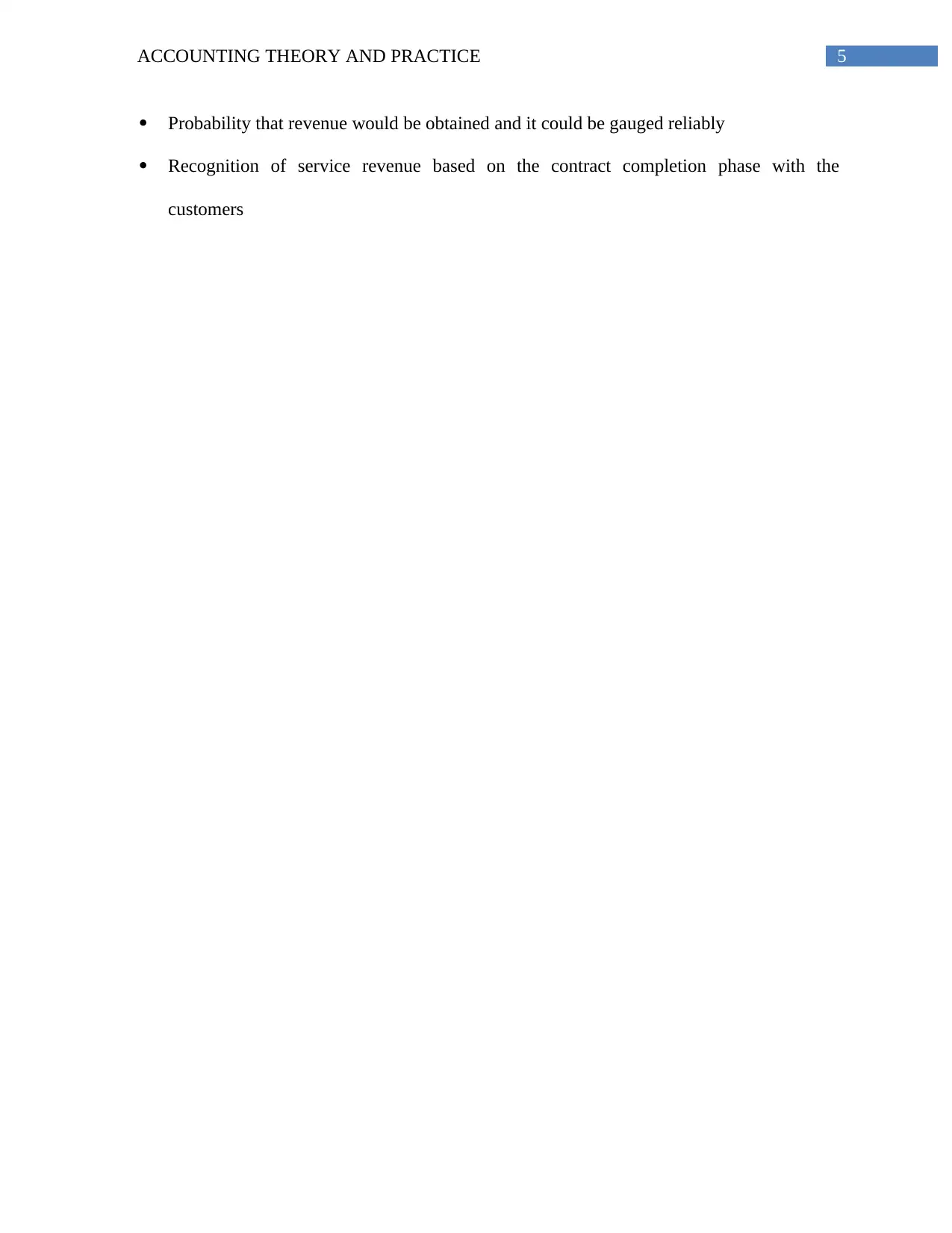
5ACCOUNTING THEORY AND PRACTICE
Probability that revenue would be obtained and it could be gauged reliably
Recognition of service revenue based on the contract completion phase with the
customers
Probability that revenue would be obtained and it could be gauged reliably
Recognition of service revenue based on the contract completion phase with the
customers
⊘ This is a preview!⊘
Do you want full access?
Subscribe today to unlock all pages.

Trusted by 1+ million students worldwide
1 out of 6
Related Documents
Your All-in-One AI-Powered Toolkit for Academic Success.
+13062052269
info@desklib.com
Available 24*7 on WhatsApp / Email
![[object Object]](/_next/static/media/star-bottom.7253800d.svg)
Unlock your academic potential
Copyright © 2020–2025 A2Z Services. All Rights Reserved. Developed and managed by ZUCOL.





